Daily Journal
September 23, 2004:
Teachers at Sea
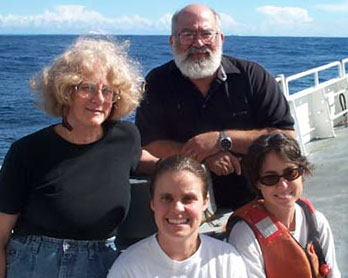
The scientists on board: Barry in the back;
front row from left to right, Ev, Krista, and Zanna.
What Are the Scientists Doing?
Krista Longnecker, PhD in Oceanography doing Post Doctoral work
Krista is Chief Scientist on this cruise. She is working at OSU to gain
further experience. In addition to running her own experiments, she is in
charge of scheduling and coordinating all the work of the other
scientists. Her experiments involve looking at bacteria and their
involvement in various processes that take place in the ocean. She filters
ocean water to remove viruses and predators and then introduces tracers to
mark the bacteria to simulate ocean conditions in the lab.
Krista's advice to our students is to try different things. She began her
career as a large animal ecologist and is now working with microscopic
organisms. She doesn't know where she will end up, but likes her present
work.
Zanna Chase, PhD in Earth and Environmental Science
Zanna was invited by the Sherrs to do experiments with them. They are
looking specifically at the effects of copper and cadmium (two toxic
metals) on single-celled organisms. These metals occur naturally in deep
water, but are brought to the surface by upwelling. Zanna is also building
an instrument to measure copper in water to study the effects of man-made
pollution.
Zanna says there are many reasons to learn, but it is easier to learn when
you are excited and love the work. Find something that pleases you and
then work hard to attain your goal.

Graduate students and technicians from left to right:
Aaron, EJ, Amanda, Sarah, and Kristin.
Aaron Hartz, PhD Graduate student
Aaron earned his B.S. in Environmental Science, then his M.S. in Marine
Biology. He is primarily assisting the other scientists on this cruise. He
is also doing his own experiments to determine the growth rate of
flagellates in sea water. Most of his research is done in the lab at OSU.
Aaron is an avid surfer.
He would like our students to know that no matter what, when it seems like
circumstances are over your head, keep plugging away. If your head is
barely above water, you're doing okay. If your head is too far above
water, it's too easy.
EJ Etherington, PhD Graduate student in Biological Oceanography
EJ undergraduate degree is in biology and outdoor recreation. He is
assisting in the research going on here aboard the Wecoma. He primarily is
filtering phytoplankon which contain chlorophyll. He is preparing samples
to calibrate instruments on board and at the OSU lab on campus. When not
working, EJ enjoys kayaking the rivers in Oregon.
His plan: I'm following a path, I don't know if it's the right path, but
I'm sticking with it, we'll see how it turns out. His advice is to begin
your journey and see where it leads you.
Amanda Ashe, Research Technician
Amanda has a B.S. degree in biology and environmental science. She is
doing research for other scientists that involve phytoplankton physiology
and their relationship to light. She is also investigating carbon uptake
of microorganisms in relation to light. Amanda is collecting samples of
sea water microorganisms and freezing them for further study on land. She
wants to determine which organisms take up the most carbon, focusing on
diatoms, bacteria, and other organisms who photosynthesize the carbon.
Her advice to our students is don't be afraid to ask questions. The only
dumb question is the one not asked.
Sarah Sowell, PhD Graduate student in Molecular and Cellular Biology
Sarah does proteonics using Mass Spectrometry. In layman's terms she
studies proteins within an organism. She looks at cells under varying
conditions to see whether the proteins change. On this cruise she is using
ocean bacteria in her study. In simple terms, the Spectrometer smashes
particles of proteins into pieces to compare their protein structure. She
would eventually like to do disease research.
She wants to tell students that school and higher education is important
but not essential. She does, however, think a GED and training in a chosen
field is critical. It is also important to choose a field you really love.
Kristin Landgren, Second Year Undergraduate in Biology
Kristin works with Sam and Amanda in Ricardo Letelier's lab at OSU. She
began as a volunteer and then worked into a paid position. This is her
first cruise. She is operating the photosynthetron to determine how
phytoplankton responds to different levels of light. She also operates the
an instrument which measures fluorescence and takes additional data.
She would like our students to know that if you are interested in a field,
don't be afraid to seek out people in the field. People are usually
excited to share their experience and knowledge. Volunteer in the field
you're interested in to learn whether you'll like it or not.
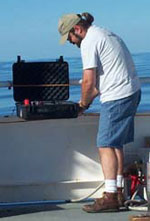 Sam Laney, PhD Graduate student in Biological Oceanography Sam Laney, PhD Graduate student in Biological Oceanography
Sam is studying how phytoplankton react and change over the course of one
day, which is their life span. He also wants to make sure Kristin has a
positive experience while on board the Wecoma.
He grew up in rural Maine, where there was little emphasis on further
education. He is the first person in his family to attend college. He says
anyone can attend college, it just takes hard work. Scientists are not
necessarily smarter, they just work harder than other people. There is a
special Marine Science program at OSU for Native Americans, women, and
minorities. Money is available for education to those people who seek it
out.
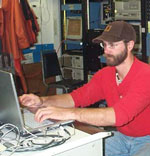 Daryl Swensen, Marine Technician Daryl Swensen, Marine Technician
onboard the R/V Wecoma
Daryl has a B.S. in Environmental Science, with minors in Archaeology and
Anthropology. He acts as a liaison between the science party on board and
the crew. He maintains the scientific data collection equipment, which
includes anything which interfaces with the science community. He makes
sure anything deployed over the side of the ship is done so safely.
Daryl was the first in his family to graduate from college and one of the
few to graduate from high school. His family worked in logging and the
fishing industry. His parents encouraged him to go to college, but he paid
his own way. He wants students to know there is money available in
scholarships and grants, much of which goes unclaimed each year.
Above top: Sam with his baby, the TSRB
Above bottom: Daryl at the computer in the Electronics Lab
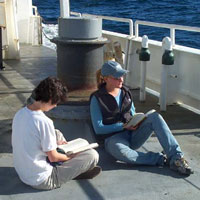 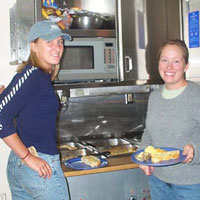
Left: Zanna and Kristin reading novels on the Aft Deck
Right: Kristin and Amanda's favorite place, the Lunch Line
Math problem for today:
The Rosette used to collect water samples from the
ocean descends at 30 meters per minute until it reaches a depth of 100
meters. After that it speeds up and travels at 60 meters per minute. Today
the scientists are sampling water at a depth of 3,000 meters. How long
will it take the Rosette to get to that depth?
The return trip up goes at the same rate. What is the total time it will
take for the Rosette to go both ways?
Back to Daily Journals

|







